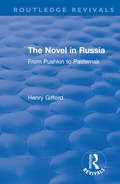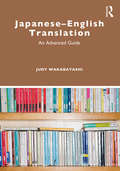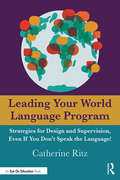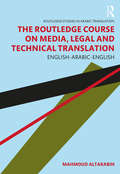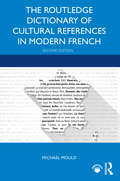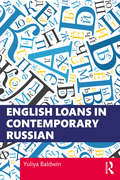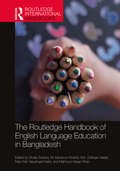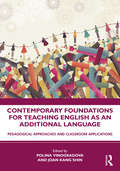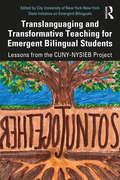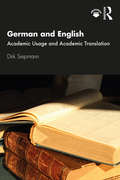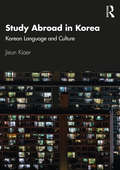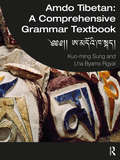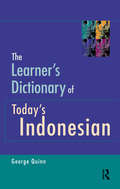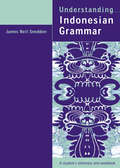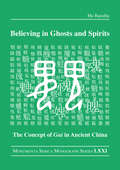- Table View
- List View
The Novel in Russia: From Pushkin to Pasternak
by Henry GiffordThe Novel in Russia examines the Russian sensibility as it is revealed in prose fiction, the dominant mode of Russian literature. It explores how, in the work of Pushkin, Lermontov and Gogol, narrative art forsakes poetry for prose, and considers in turn six authors from the great age of prose realism: Goncharov, Turgenev, Leskov, Tolstoy, Saltykov-Shchedrin and Dostoevsky. The book provides an account of Chekhov and Gorky, appraises 'decadent' prose, the earlier Soviet writing, the school of Socialist Realism, and Doctor Zhivago. The theme of the writer's contest with critical pressure and State interference runs throughout.
The Novel in Russia: From Pushkin to Pasternak
by Henry GiffordThe Novel in Russia examines the Russian sensibility as it is revealed in prose fiction, the dominant mode of Russian literature. It explores how, in the work of Pushkin, Lermontov and Gogol, narrative art forsakes poetry for prose, and considers in turn six authors from the great age of prose realism: Goncharov, Turgenev, Leskov, Tolstoy, Saltykov-Shchedrin and Dostoevsky. The book provides an account of Chekhov and Gorky, appraises 'decadent' prose, the earlier Soviet writing, the school of Socialist Realism, and Doctor Zhivago. The theme of the writer's contest with critical pressure and State interference runs throughout.
Japanese–English Translation: An Advanced Guide
by Judy WakabayashiThis volume is a textbook for aspiring translators of Japanese into English, as well as a reference work for professional Japanese–English translators and for translator educators. Underpinned by sound theoretical principles, it provides a solid foundation in the practice of Japanese–English translation, then extends this to more advanced levels. Features include: 13 thematic chapters, with subsections that explore common pitfalls and challenges facing Japanese–English translators and the pros and cons of different procedures exercises after many of these subsections abundant examples drawn from a variety of text types and genres and translated by many different translators This is an essential resource for postgraduate students of Japanese–English translation and Japanese language, professional Japanese–English translators and translator educators. It will also be of use and interest to advanced undergraduates studying Japanese.
Japanese–English Translation: An Advanced Guide
by Judy WakabayashiThis volume is a textbook for aspiring translators of Japanese into English, as well as a reference work for professional Japanese–English translators and for translator educators. Underpinned by sound theoretical principles, it provides a solid foundation in the practice of Japanese–English translation, then extends this to more advanced levels. Features include: 13 thematic chapters, with subsections that explore common pitfalls and challenges facing Japanese–English translators and the pros and cons of different procedures exercises after many of these subsections abundant examples drawn from a variety of text types and genres and translated by many different translators This is an essential resource for postgraduate students of Japanese–English translation and Japanese language, professional Japanese–English translators and translator educators. It will also be of use and interest to advanced undergraduates studying Japanese.
Leading Your World Language Program: Strategies for Design and Supervision, Even If You Don’t Speak the Language!
by Catherine RitzAn essential resource for district, school, and program leaders who supervise, evaluate, or otherwise support World Language programs, this book provides clear, practical guidance on leading an exemplary K–12 World Language program. No matter whether you speak the language, the effective approaches in this book will equip you with the tools you need to implement and evaluate World Language curricula in your school. Catherine Ritz provides a clear and research-based framework for World Language instruction aligned to rigorous national and state standards, and addresses essential concepts and topics, including program and curriculum design, assessment and evaluation, and strategic planning. Whether you are a World Language department chair with years of experience, a school administrator with no background in language education, or a World Language teacher, you will find much to use in this book. It is chock-full of ready-to-use resources and tools, including: Templates for program and unit planning, observation protocols, and sample assessments World LAnguage program models for different age ranges, and a sample curriculum unit Additional resource lists and further reading recommendations.
Leading Your World Language Program: Strategies for Design and Supervision, Even If You Don’t Speak the Language!
by Catherine RitzAn essential resource for district, school, and program leaders who supervise, evaluate, or otherwise support World Language programs, this book provides clear, practical guidance on leading an exemplary K–12 World Language program. No matter whether you speak the language, the effective approaches in this book will equip you with the tools you need to implement and evaluate World Language curricula in your school. Catherine Ritz provides a clear and research-based framework for World Language instruction aligned to rigorous national and state standards, and addresses essential concepts and topics, including program and curriculum design, assessment and evaluation, and strategic planning. Whether you are a World Language department chair with years of experience, a school administrator with no background in language education, or a World Language teacher, you will find much to use in this book. It is chock-full of ready-to-use resources and tools, including: Templates for program and unit planning, observation protocols, and sample assessments World LAnguage program models for different age ranges, and a sample curriculum unit Additional resource lists and further reading recommendations.
The Routledge Course on Media, Legal and Technical Translation: English-Arabic-English (Routledge Studies in Arabic Translation)
by Mahmoud AltarabinThe Routledge Course on Media, Legal and Technical Translation: English-Arabic-English is an indispensable and engaging coursebook for university students wishing to develop their English-Arabic-English translation skills in these three text types. Taking a practical approach, the book introduces Arab translation students to common translation strategies in addition to the linguistic, syntactic, and stylistic features of media, legal, and technical texts. This book features texts carefully selected for their technical relevance. The key features include: • comprehensive four chapters covering media, legal, and technical texts, which are of immense importance to Arab translation students; • detailed and clear explanations of the lexical, syntactic, and stylistic features of English and Arabic media, legal, and technical texts; • up-to-date and practical translation examples in both directions offering students actual experiences of professional translators; • authentic texts extracted from various sources to promote students’ familiarity with language features and use; • extensive range of exercises following each section of the book to enable students to test and practice the knowledge and skills they developed from reading previous sections; • glossaries following most exercises containing the translation of difficult words; and • a list of recommended readings following each chapter. The easy, practical, and comprehensive approach adopted in the book makes it a must-have coursebook for intermediate and advanced students studying translation between English and Arabic. University instructors and professional translators working on translation between English and Arabic will find this book particularly useful.
The Routledge Course on Media, Legal and Technical Translation: English-Arabic-English (Routledge Studies in Arabic Translation)
by Mahmoud AltarabinThe Routledge Course on Media, Legal and Technical Translation: English-Arabic-English is an indispensable and engaging coursebook for university students wishing to develop their English-Arabic-English translation skills in these three text types. Taking a practical approach, the book introduces Arab translation students to common translation strategies in addition to the linguistic, syntactic, and stylistic features of media, legal, and technical texts. This book features texts carefully selected for their technical relevance. The key features include: • comprehensive four chapters covering media, legal, and technical texts, which are of immense importance to Arab translation students; • detailed and clear explanations of the lexical, syntactic, and stylistic features of English and Arabic media, legal, and technical texts; • up-to-date and practical translation examples in both directions offering students actual experiences of professional translators; • authentic texts extracted from various sources to promote students’ familiarity with language features and use; • extensive range of exercises following each section of the book to enable students to test and practice the knowledge and skills they developed from reading previous sections; • glossaries following most exercises containing the translation of difficult words; and • a list of recommended readings following each chapter. The easy, practical, and comprehensive approach adopted in the book makes it a must-have coursebook for intermediate and advanced students studying translation between English and Arabic. University instructors and professional translators working on translation between English and Arabic will find this book particularly useful.
The Routledge Dictionary of Cultural References in Modern French
by Michael MouldNow in its second edition, The Routledge Dictionary of Cultural References in Modern French reveals the hidden cultural dimension of contemporary French, as used in the press, going beyond the limited and purely lexical approach of traditional bilingual dictionaries. Even foreign learners of French who possess a good level of French often have difficulty in fully understanding French articles, not because of any linguistic shortcomings on their part but because of their inadequate knowledge of the cultural references. This cultural dictionary of French provides the reader with clear and concise explanations of the crucial cultural dimension behind the most frequently used words and phrases found in the contemporary French press. This vital background information, gathered here in this innovative and entertaining dictionary, will allow readers to go beyond a superficial understanding of the French press and the French language in general to see the hidden yet implied cultural significance that is so transparent to the native speaker. This fully revised second edition includes: a broad range of cultural references from the historical and literary to the popular and classical; an enhanced analysis of punning mechanisms used in the press; over 3,000 cultural references explained with updated examples; a three-level indicator of frequency; new and expanded chapters on the French of Quebec, institutional and academic references, and English borrowings in the areas of IT and medical science; over 600 online questions to test knowledge before and after reading. The Routledge Dictionary of Cultural References in Modern French is the ideal reference for all undergraduate and postgraduate students of French seeking to enhance their understanding of the French language. It will also be of interest to teachers, translators and Francophiles alike. French students in khâgne, Sciences-Po and schools of journalism will also find this book valuable and relevant for their studies. Test questions and solutions are available at www.routledge.com/9780367376758, in addition to three online chapters. These bonus chapters explore figurative expressions involving the names of animals, the language of the law and slang terms.
The Routledge Dictionary of Cultural References in Modern French
by Michael MouldNow in its second edition, The Routledge Dictionary of Cultural References in Modern French reveals the hidden cultural dimension of contemporary French, as used in the press, going beyond the limited and purely lexical approach of traditional bilingual dictionaries. Even foreign learners of French who possess a good level of French often have difficulty in fully understanding French articles, not because of any linguistic shortcomings on their part but because of their inadequate knowledge of the cultural references. This cultural dictionary of French provides the reader with clear and concise explanations of the crucial cultural dimension behind the most frequently used words and phrases found in the contemporary French press. This vital background information, gathered here in this innovative and entertaining dictionary, will allow readers to go beyond a superficial understanding of the French press and the French language in general to see the hidden yet implied cultural significance that is so transparent to the native speaker. This fully revised second edition includes: a broad range of cultural references from the historical and literary to the popular and classical; an enhanced analysis of punning mechanisms used in the press; over 3,000 cultural references explained with updated examples; a three-level indicator of frequency; new and expanded chapters on the French of Quebec, institutional and academic references, and English borrowings in the areas of IT and medical science; over 600 online questions to test knowledge before and after reading. The Routledge Dictionary of Cultural References in Modern French is the ideal reference for all undergraduate and postgraduate students of French seeking to enhance their understanding of the French language. It will also be of interest to teachers, translators and Francophiles alike. French students in khâgne, Sciences-Po and schools of journalism will also find this book valuable and relevant for their studies. Test questions and solutions are available at www.routledge.com/9780367376758, in addition to three online chapters. These bonus chapters explore figurative expressions involving the names of animals, the language of the law and slang terms.
English Loans in Contemporary Russian
by Yuliya BaldwinEnglish Loans in Contemporary Russian presents over 2,000 English borrowings in the Russian lexicon, providing a unique account of changes in the language and culture. The entries in this practical Russian-English dictionary cover a wide range of well-established loanwords to more recent neologisms. They address an increasingly relevant part of the contemporary Russian lexicon, particularly in the language of business, politics, mass media, computer, medicine, and other professional areas. The dictionary reflects how the language is responding to new patterns of life and will be of interest to Russian language learners and linguists.
English Loans in Contemporary Russian
by Yuliya BaldwinEnglish Loans in Contemporary Russian presents over 2,000 English borrowings in the Russian lexicon, providing a unique account of changes in the language and culture. The entries in this practical Russian-English dictionary cover a wide range of well-established loanwords to more recent neologisms. They address an increasingly relevant part of the contemporary Russian lexicon, particularly in the language of business, politics, mass media, computer, medicine, and other professional areas. The dictionary reflects how the language is responding to new patterns of life and will be of interest to Russian language learners and linguists.
The Routledge Handbook of English Language Education in Bangladesh (Routledge International Handbooks of Education)
by Shaila Sultana M. Moninoor Roshid Zulfeqar Haider Mian Naushaad Kabir Mahmud Hasan KhanThis Handbook is a comprehensive overview of English language education in Bangladesh. Presenting descriptive, theoretical, and empirical chapters as well as case studies, this Handbook, on the one hand, provides a comprehensive view of the English language teaching and learning scenario in Bangladesh, and on the other hand comes up with suggestions for possible decolonisation and de-eliticisation of English in Bangladesh. The Handbook explores a wide range of diverse endogenous and exogenous topics, all related to English language teaching and learning in Bangladesh, and acquaints readers with different perspectives, operating from the macro to the micro levels. The theoretical frameworks used are drawn from applied linguistics, education, sociology, political science, critical geography, cultural studies, psychology, and economics. The chapters examine how much generalisability the theories have for the context of Bangladesh and how the empirical data can be interpreted through different theoretical lenses. There are six sections in the Handbook covering different dynamics of English language education practices in Bangladesh, from history, policy and practice to assessment, pedagogy and identity. It is an invaluable reference source for students, researchers, and policy makers interested in English language, ELT, TESOL, and applied linguistics.
The Routledge Handbook of English Language Education in Bangladesh (Routledge International Handbooks of Education)
by Shaila Sultana M. Moninoor Roshid Md. Zulfeqar Haider Mian Md. Naushaad Kabir Mahmud Hasan KhanThis Handbook is a comprehensive overview of English language education in Bangladesh. Presenting descriptive, theoretical, and empirical chapters as well as case studies, this Handbook, on the one hand, provides a comprehensive view of the English language teaching and learning scenario in Bangladesh, and on the other hand comes up with suggestions for possible decolonisation and de-eliticisation of English in Bangladesh. The Handbook explores a wide range of diverse endogenous and exogenous topics, all related to English language teaching and learning in Bangladesh, and acquaints readers with different perspectives, operating from the macro to the micro levels. The theoretical frameworks used are drawn from applied linguistics, education, sociology, political science, critical geography, cultural studies, psychology, and economics. The chapters examine how much generalisability the theories have for the context of Bangladesh and how the empirical data can be interpreted through different theoretical lenses. There are six sections in the Handbook covering different dynamics of English language education practices in Bangladesh, from history, policy and practice to assessment, pedagogy and identity. It is an invaluable reference source for students, researchers, and policy makers interested in English language, ELT, TESOL, and applied linguistics.
Contemporary Foundations for Teaching English as an Additional Language: Pedagogical Approaches and Classroom Applications
by Polina Vinogradova Joan Kang ShinThis engaging volume on English as an Additional Language (EAL), argues persuasively for the importance of critical participatory pedagogies that embrace multilingualism and multimodality in the field of TESOL. It highlights the role of the TESOL profession in teaching for social justice and advocacy and explores how critical participatory pedagogies translate into English language teaching and teacher education around the world. Bringing together diverse scholars in the field and practicing English language teachers, editors Polina Vinogradova and Joan Kang Shin present 10 thematically organized units that demonstrate that language teaching pedagogy must be embedded in the larger sociocultural contexts of teaching and learning to be successful. Each unit covers one pedagogical approach and includes three case studies to illustrate how English language teachers across the world implement these approaches in their classrooms. The chapters are supplemented by discussion questions and a range of practical sources for further exploration. Addressing established and emerging areas of TESOL, topics covered include: Critical and postmethod pedagogies Translingualism Digital literacy and multiliteracies Culturally responsive pedagogy Advocacy Featuring educators implementing innovative approaches in primary, secondary, and tertiary contexts across borders, Contemporary Foundations for Teaching English as an Additional Language is an ideal text for methods and foundational courses in TESOL and will appeal to in-service and preservice English language teachers as well as students and teacher educators in TESOL and applied linguistics.
Contemporary Foundations for Teaching English as an Additional Language: Pedagogical Approaches and Classroom Applications
by Polina Vinogradova; Joan Kang ShinThis engaging volume on English as an Additional Language (EAL), argues persuasively for the importance of critical participatory pedagogies that embrace multilingualism and multimodality in the field of TESOL. It highlights the role of the TESOL profession in teaching for social justice and advocacy and explores how critical participatory pedagogies translate into English language teaching and teacher education around the world. Bringing together diverse scholars in the field and practicing English language teachers, editors Polina Vinogradova and Joan Kang Shin present 10 thematically organized units that demonstrate that language teaching pedagogy must be embedded in the larger sociocultural contexts of teaching and learning to be successful. Each unit covers one pedagogical approach and includes three case studies to illustrate how English language teachers across the world implement these approaches in their classrooms. The chapters are supplemented by discussion questions and a range of practical sources for further exploration. Addressing established and emerging areas of TESOL, topics covered include: Critical and postmethod pedagogies Translingualism Digital literacy and multiliteracies Culturally responsive pedagogy Advocacy Featuring educators implementing innovative approaches in primary, secondary, and tertiary contexts across borders, Contemporary Foundations for Teaching English as an Additional Language is an ideal text for methods and foundational courses in TESOL and will appeal to in-service and preservice English language teachers as well as students and teacher educators in TESOL and applied linguistics.
Translanguaging and Transformative Teaching for Emergent Bilingual Students: Lessons from the CUNY-NYSIEB Project
by City University City University of New York-New York State Initiative on Emergent BilingualsA critical and accessible text, this book provides a foundation for translanguaging theory and practice with educating emergent bilingual students. The product of the internationally renowned and trailblazing City University of New York-New York State Initiative on Emergent Bilinguals (CUNY-NYSIEB), this book draws on a common vision of translanguaging to present different perspectives of its practice and outcomes in real schools. It tells the story of the collaborative project’s positive impact on instruction and assessment in different contexts, and explores the potential for transformation in teacher education. Acknowledging oppressive traditions and obstacles facing language minoritized students, this book provides a pathway for combatting racism, monolingualism, classism and colonialism in the classroom and offers narratives, strategies and pedagogical practices to liberate and engage emergent bilingual students. This book is an essential text for all teacher educators, researchers, scholars, and students in TESOL and bilingual education, as well as educators working with language minoritized students.
Translanguaging and Transformative Teaching for Emergent Bilingual Students: Lessons from the CUNY-NYSIEB Project
by Ofelia GarcíaA critical and accessible text, this book provides a foundation for translanguaging theory and practice with educating emergent bilingual students. The product of the internationally renowned and trailblazing City University of New York-New York State Initiative on Emergent Bilinguals (CUNY-NYSIEB), this book draws on a common vision of translanguaging to present different perspectives of its practice and outcomes in real schools. It tells the story of the collaborative project’s positive impact on instruction and assessment in different contexts, and explores the potential for transformation in teacher education. Acknowledging oppressive traditions and obstacles facing language minoritized students, this book provides a pathway for combatting racism, monolingualism, classism and colonialism in the classroom and offers narratives, strategies and pedagogical practices to liberate and engage emergent bilingual students. This book is an essential text for all teacher educators, researchers, scholars, and students in TESOL and bilingual education, as well as educators working with language minoritized students.
German and English: Academic Usage and Academic Translation
by Dirk SiepmannGerman and English: Academic Usage and Academic Translation focuses on academic and popular scientific/academic usage.This book’s brief is both theoretical and practical: on the theoretical side, it aims to provide a systematic, corpus-based account of current academic usage in English and in German as well as of the translation problems associated with various academic genres; on the practical side, it seeks to equip academic translators with the skills required to produce target-language text in accordance with disciplinary conventions. The main perspective taken is that of a translator working from German into English, but the converse direction is also regularly taken into account. Most of the examples used are based on errors that occurred in real-life translation jobs. Additional practice materials and sample translations are available as eResources here: www.routledge.com/9780367619022.This book will be an important resource for professionals aspiring to translate academic texts, linguists interested in academic usage, translation scholars, and graduate and post-graduate students.
German and English: Academic Usage and Academic Translation
by Dirk SiepmannGerman and English: Academic Usage and Academic Translation focuses on academic and popular scientific/academic usage.This book’s brief is both theoretical and practical: on the theoretical side, it aims to provide a systematic, corpus-based account of current academic usage in English and in German as well as of the translation problems associated with various academic genres; on the practical side, it seeks to equip academic translators with the skills required to produce target-language text in accordance with disciplinary conventions. The main perspective taken is that of a translator working from German into English, but the converse direction is also regularly taken into account. Most of the examples used are based on errors that occurred in real-life translation jobs. Additional practice materials and sample translations are available as eResources here: www.routledge.com/9780367619022.This book will be an important resource for professionals aspiring to translate academic texts, linguists interested in academic usage, translation scholars, and graduate and post-graduate students.
Study Abroad in Korea: Korean Language and Culture
by Jieun KiaerStudy Abroad in Korea prepares students for study in Korean by providing the reader with key expressions and guidance on certain aspects of culture and language idiosyncratic to Korea, focusing on everyday scenarios. Key features include: Key expressions throughout the book, providing practical linguistic knowledge with jargon-free explanations. Exposes readers to contextualised, real-life situations through dialogues between two characters, one of whom is bilingual and teaching in Korea; the other is a student studying abroad. Discussions of important historical events and social issues accompany relevant chapters. Features a variety of dialects and varieties of spoken Korean to help students acclimatise to the diverse types of spoken Korean they will encounter. Aimed at those who possess a basic knowledge of Korean who wish to develop their linguistic knowledge in preparation for relocation to Korea, this book is ideal for lower-intermediate and A2-level students of Korean or for self-study.
Amdo Tibetan: ༄༄།། ཨ་མདོའི་ཁ་སྐད།
by Kuo-ming Sung Lha Byams RgyalAmdo Tibetan: A Comprehensive Grammar Textbook is a rigorous one-year college-level textbook for English speakers who wish to learn the Amdo dialect of the Tibetan language. This comprehensive introduction to the language provides dialogues at the start of each new lesson to illustrate the constructions covered in that lesson. Material from previous chapters is recycled within these dialogues to reinforce learning as the lessons progress. Each chapter unpacks the opening sample dialogue and provides an in-depth analysis and technical explanations of the specific constructions presented. Cultural sections are also included in each chapter, as well as a range of exercises and drills to reinforce learning and help students internalize the new information. The book will be of particular interest to linguists and students with some knowledge of either standard colloquial or literary Tibetan.
The Learner's Dictionary of Today's Indonesian
by George QuinnWhat are the 24 words for 'you' in Indonesian? Why does Indonesian have four words for 'rice but no exact equivalent of 'farm'? How do you say 'Bang!' 'Ouch!' and 'Eh?'. What is the difference between dong and doang in colloquial Indonesian? How did the name of the Hindu god Indra give us the modern Indonesian word for motor vehicle?Whether you are a beginner or an advanced student of Indonesian, The Learner's Dictionary of Today's Indonesian is an essential tool to help you gain an authentic, up-to-date, and active command of the language. It provides a wholly new, very detailed snapshot of the core vocabulary of Indonesian.Among its features are:* thousand of illustrative sentences* an easy pronunciation guide* extensive cross-referencing* helpful tips on usage* topic lists which group the dictionary's words according to 42 'common usage' areas, including time, colours, daily activities, the home, sport, occupations, mass media, religion and business.A unique feature of the dictionary is the dozens of boxes giving invaluable information on everyday usage, word origins and nuances of meaning.Rich in information on the cultural context in which words are used, it includes notes on the difficulties learners experience arising from differences in culture and history between English-speakers and Indonesian-speakers. The Learner's Dictionary of Today's Indonesian is the first comprehensive dictionary designed specifically to help you gain a practical command of the national language of one of the world's most populous nations.
Understanding Indonesian Grammar: A student's reference and workbook
by James Neil SneddonUnderstanding Indonesian Grammar is a reference and workbook designed primarily for intermediate and advanced students in senior years of high school and at university. It provides a clear, non-technical description of the important structures in the language, together with practical exercises. It can be used with any Indonesian language course. * Units are largely self-contained, enabling teachers to select topics in any order, depending on the structure of their course and the needs of their students.* The various aspects of each topic are discussed one at a time and tested in exercises so that the learner is guided step by step to an in-depth understanding of the topic.* Contains descriptions of many frequently occurring affixes and structures which are not dealt with in existing course materials. * Clear explanations and answers to all exercises enable learners to use the book without a teacher.* Notes throughout the book provide additional information on unusual or irregular features of grammar. * All grammatical terms used are defined in an extensive glossary.The comprehensiveness and flexibility of Understanding Indonesian Grammar make it an indispensable resource for students and teachers of Indonesian.James Neil Sneddon PhD is an associate professor in the School of Languages at Griffith University, with long experience teaching Indonesian language and linguistics. He is the author of Indonesian Reference Grammar (1996).
Believing in Ghosts and Spirits: The Concept of Gui in Ancient China (Monumenta Serica Monograph Series)
by Hu BaozhuThe present book by Hu Baozhu explores the subject of ghosts and spirits and attempts to map the religious landscape of ancient China. The main focus of attention is the character gui 鬼, an essential key to the understanding of spiritual beings. The author analyses the character gui in various materials – lexicons and dictionaries, excavated manuscripts and inscriptions, and received classical texts. Gui is examined from the perspective of its linguistic root, literary interpretation, ritual practices, sociopolitical implication, and cosmological thinking. In the gradual process of coming to know the otherworld in terms of ghosts and spirits, Chinese people in ancient times attempted to identify and classify these spiritual entities. In their philosophical thinking, they connected the subject of gui with the movement of the universe. Thus the belief in ghosts and spirits in ancient China appeared to be a moral standard for all, not only providing a room for individual religiosity but also implementing the purpose of family-oriented social order, the legitimization of political operations, and the understanding of the way of Heaven and Earth.
